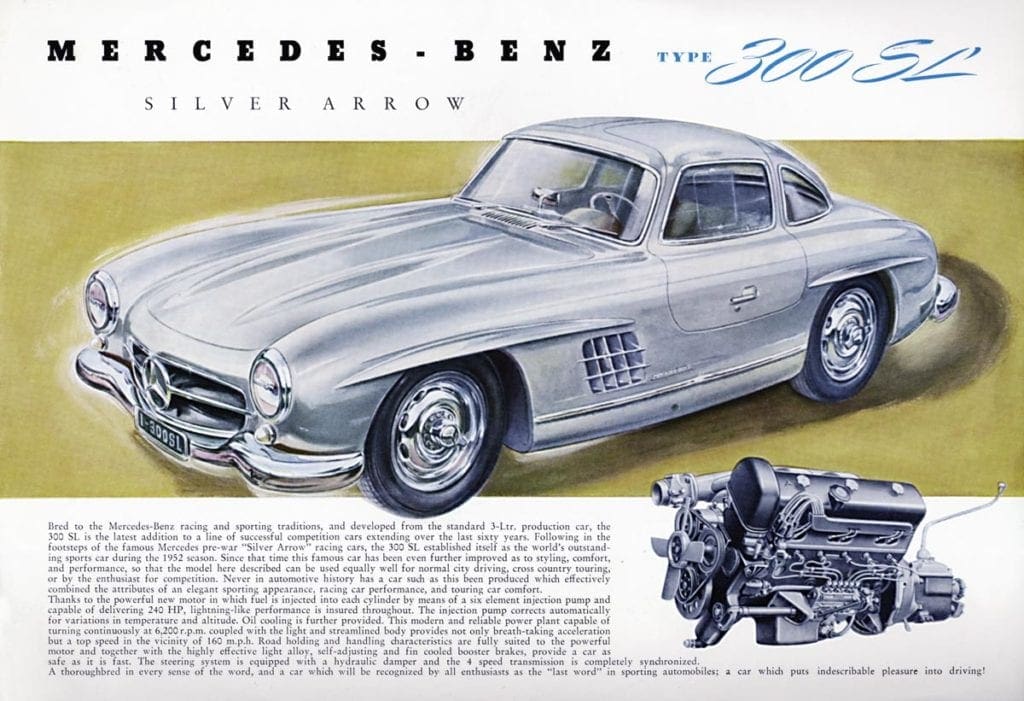This car was capable of racing successfully right off the showroom floor. It is in unrestored, original condition, and was acquired from a New York Times classified ad in 1970.
THESE CARS
In 1954, they introduced the SL (Sport Light). Because its low-slung chassis incorporated a frame which extended over to the side of the body, Mercedes hinged the doors at the roof, thus giving the gull wing appearance when both opened. This car had many design features besides its doors, most notably the fact it was the first production car with fuel injection. It had an overhead valve inline 6-cylinder engine of 3-liter capacity which developed 190 horsepower. In line with the 4-speed manual transmission, rack and pinion steering, and independent front and swing axle rear suspension, the top speed of 152 miles per hour was reasonable with a 0-60 in 7.2 seconds.
The car was introduced shortly after Daimler-Benz had converted its war effort and in 1952 they were victorious in the World Sports Car Manufacturers Championship and in the recently formed Sports Car category. American distributor Max Hoffman recognized the market for this car in the United States and after successful sales in 1954, he received his first order on this side of the ocean in March 1955. 1400 Gullwings were manufactured from 1954 to 1956 of which 1100 came to the United States distributed by Mr. Hoffman.
The cramped quarters and the heat control in the coupe led to the development of a roadster with similar chassis but with modifications, such as disc brakes unveiled in 1957. The beautiful lines of the roadster are incomparable for any car of its time. With the 6-cylinder engine tilted it was possible to achieve a low hood line which complemented the functional streamlining of the rest of the car. These cars could engage in various types of road racing, “right out of the box,” from a dealer’s showroom floor. Approximately 26
OUR CAR
In 1970, while casually reading The New York Times, I read an ad from a Philadelphia suburbanite advertising that a low mileage Mercedes Gullwing was for sale. After a brief phone call, the owner knew that I was on my way. The owner, a pool builder, took the car for his work, only to find that his wife found the care too difficult to manage, hot, and not useful for uxorial duties. We quickly exchanged cash, and I drove her home. Since then little has been done.
With about 38,000 miles and no major repairs, she was a serviceable car which got some extra activity as a pure passenger vehicle, though when parked on the street one day, I lost the Becker radio forever. I have found that speeding up during a rapid turn produces some funny things near the rear of the car, which I do not want to relive. Nevertheless, the acceleration is remarkable, shifting is easy, and steering is precise.
For exhibition and because she has the beautiful Rudge knockoff wheels, we removed the bumpers and put her in the configuration as she would have looked had she took part in Watkins Glen. When one looks at the entire spectrum of sports cars from the 1950s that were readily available in America, and that could produce the excitement of a racing machine, the Gullwing ranks high, yet with enough conveniences to be more useful than the open bodied all-out sports racing cars.

The 300 SL Coupe is the ultimate in an all-around sports car. It combines more desirable features in one streamlined package than we ever imagined or hoped would be possible.
Autoblog.com










